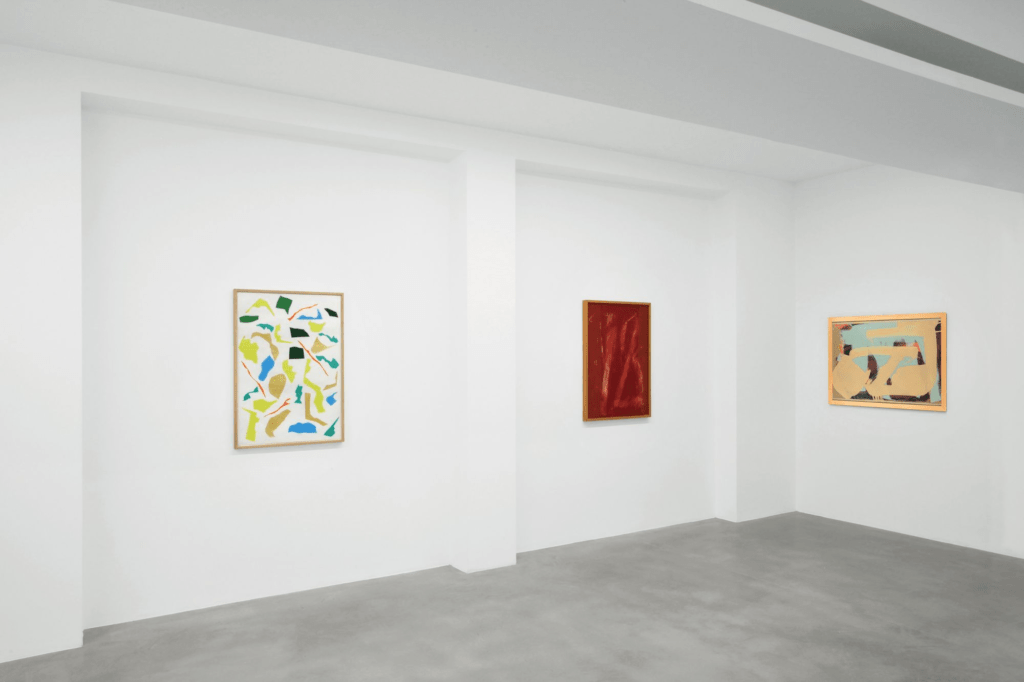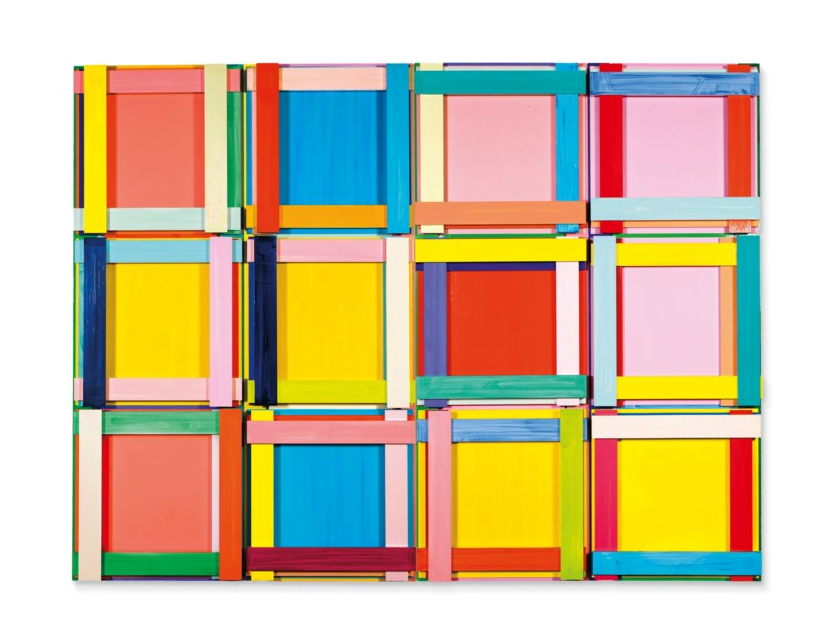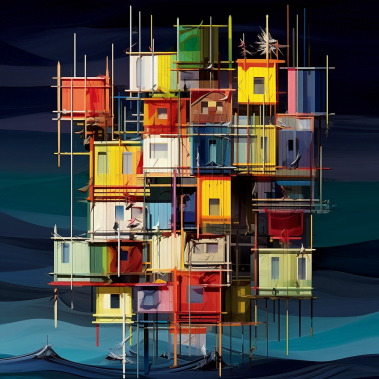Imi Knoebel
As an artist who has dedicated over 50 years to challenging preconceptions about art, Imi Knoebel deserves attention and recognition. Imi Knoebel’s story serves as an inspiration. His dedication to his artistic vision despite facing many obstacles and setbacks in his career is admirable.
Knoebel never wavered in his commitment to minimalism and pushing the boundaries of contemporary art. His perseverance and belief in himself and his work ultimately paid off, leading to international recognition and acclaim.
Though his art may seem simple, Knoebel’s paintings and sculptures explore complex ideas related to color, form, and space. His life’s work serves as a reminder that staying true to one’s creative spirit can lead to great success and leave behind a lasting legacy. Knoebel’s minimalist masterpieces will continue to captivate art lovers for generations to come.
Imi Knoebel BIOGRAPHY

Early Life and Education
Imi Knoebel born in 1940 in Dessau, Germany. His father was an architect who instilled in him an appreciation for art and design from an early age. Knoebel developed an interest in art as a student, studying painting at the Dresden Art Academy in the late 1950s and early 1960s.
Studies and Influences
While studying in Dresden, Knoebel was exposed to a variety of modern art styles that influenced his developing practice. He was particularly drawn to Minimalism and Conceptualism. Key influences included Kasimir Malevich, Piet Mondrian, and Joseph Beuys. Knoebel was also closely aligned with a group of avant-garde artists known as the “Neue Wilde” or “New Wild Ones.”
After graduating from the Dresden Art Academy in 1964, Knoebel began experimenting with his style. Knoebel moved to Düsseldorf in 1968 where he connected with other like-minded artists associated with the Düsseldorf School of Photography.
Mature Style
Over the following decades, Knoebel continued to hone his signature minimalist style. He worked in a variety of media including painting, sculpture, drawing, and installation. His art is characterized by reduced formal language, serialization, and references to art history.
Knoebel has had major retrospectives at the Stedelijk Museum Amsterdam, Museo Reina Sofia in Madrid, and the Kunstmuseum Wolfsburg. His works are held in major museum collections around the world, cementing his status as one of the most important contemporary German artists.
What is Imi Knoebel known for?

Knoebel is known for his abstract and minimalist painting techniques using geometric forms, asymmetrical compositions, and a reduced color palette. He experiments with the interaction between color surfaces, often using primary colors like red, yellow, and blue. Knoebel’s paintings are characterized by precise, clean brushstrokes and an intuitive sense of balance. His style focuses on the formal elements of abstract art.
Career Highlights

His Artistic Career Takes Flight in the 1960s
In the 1960s, Imi Knoebel’s artistic career began to flourish. He studied at the Düsseldorf Art Academy where professors included Joseph Beuys, who became Knoebel’s mentor. Under Beuys’ influence, Knoebel began experimenting with minimalist and conceptual art.
1968 | First art installation | Consisting of bare rooms with fluorescent lights |
Becoming Internationally Recognized in the 1970s
Imi Knoebel gained international recognition for his art in the 1970s. His minimalist and conceptual pieces incorporated geometric shapes and industrial materials, capturing the spirit of post-war Germany.
In the early 1970s, Knoebel was a student at the Darmstadt art academy, where he met fellow students Blinky Palermo and Katharina Fritsch. Their professor, Johannes Cladders, introduced them to the avant-garde art movements of the time, including minimalism, conceptual art, and Arte Povera.
Throughout the 1970s, Knoebel continued experimenting with industrial materials like steel, aluminum, and fluorescent tubes, creating sculptures and site-specific installations. By the end of the decade, Knoebel had established himself as a leading contemporary artist, gaining renown for his innovative use of shape, color, and space.
His art represented a new direction in German art, breaking from the expressiveness of postwar movements. Knoebel’s conceptual, minimalist works secured his status as an internationally influential artist.
Some notable works include:
1970s | Paintings and sculptures | His early works featured simple geometric shapes, industrial materials like metal and wood, and primary colors. |
1972 | Knoebel’s art exhibition | Held at Documenta 5, a prestigious quinquennial art show in Kassel, Germany. His “raster” pieces earned him critical acclaim for their minimalist aesthetic and contemporary sensibility. |
1977 | 24 Colors–for Blinky Palermo | The series consists of 24 monochromatic panels featuring the 24 colors of a standard paint range. It is considered Knoebel’s masterpiece and has been exhibited internationally, most recently at the Art Institute of Chicago in 2017. |
1974 | Curry Painting | Notable piece |
1978 | First solo museum exhibition | Held at the Stedelijk Museum in Amsterdam |
Imi Knoebel List of Work

Notable Artworks and Exhibitions From 1980 Onwards
After establishing himself as a renowned artist in Germany, Imi Knoebel began receiving international recognition in the 1980s. Knoebel continued experimenting with shape, color, and space. His large-scale installations incorporate neon lights, aluminum panels, and synthetic materials.
1980 | first solo exhibition | Held at the DAAD Gallery in Berlin in the U.S. The show featured a series of paintings from Knoebel’s “Deutsche Welle” series. |
1986 | Red/Yellow/Blue Room | Large-scale installations |
1987-2011 | Project for Düsseldorf Cathedral | |
1987 | Represented Germany at the Venice Biennale | He created an installation titled “Raum 19″ (Room 19) comprising large aluminum panels with geometric shapes cut into them. The work explored themes of space, light, and shadow. |
1993 | Stedelijk Museum in Amsterdam | Major exhibitions of Knoebel’s work in the 1990s featuring his “Menschenbilder” (Portraits) series. |
1994 | A solo show at the Kunstmuseum Bonn | |
1999 | An exhibition at the Kunsthalle Bielefeld | |
2009 | First major retrospective in the U.S | Organized by the Philadelphia Museum of Art. The show traveled to the Kunstmuseum Winterthur in Switzerland and the Museum der Moderne in Salzburg, Austria. |
Imi Knoebel Impact
Imi Knoebel has had a significant impact on the art world through his abstract and minimalist paintings. His work explores form, color, and space conceptually. Knoebel is considered a pioneer of the German art movement known as “Neue Wilde” or “The New Savages.”
Legacy and Influence
Imi Knoebel is viewed as an influential figure in contemporary abstract art. His minimalist and conceptual approach to painting has inspired generations of artists. His masterful use of color and form demonstrates his exceptional skill and vision. Imi Knoebel’s artworks have secured his place as a pioneer of German abstract painting. Knoebel’s artistic legacy lives on through his timeless and evocative paintings.
Famous Artwork by Imi Knoebel
Titel: Imi Knoebel
Revolver I

Image © Christies – Revolver 1 – Price realised: EUR 434,500 – Closed:
12 Apr 2017
What could a NFT Story of Imi Knoebel sound like?
Step into the captivating world of Imi Knoebel’s NFT art, where traditional meets digital, and imagination knows no bounds. As a pioneering artist in the NFT realm, Knoebel’s iconic geometric and minimalist style takes on a new dimension, immersing collectors and art enthusiasts in an unparalleled digital odyssey.
With each stroke of color and form, Knoebel’s NFTs come to life on the blockchain canvas, forever preserved and authenticated. These unique digital tokens become windows into a virtual gallery, transcending geographical boundaries, and connecting people worldwide.
But the magic doesn’t stop there—Knoebel embraces interactivity, allowing collectors to engage with his art like never before. By rearranging shapes and altering colors, each viewer becomes a co-creator, unlocking new possibilities within the digital masterpiece.
Yet, beyond the aesthetic allure, Knoebel’s NFT journey carries a deeper purpose. Some NFT sales contribute to art education and heritage preservation, transforming the NFT movement into a force for positive change in the art community.
As time marches on, Imi Knoebel’s legacy intertwines with the blockchain, leaving an indelible mark on the digital art landscape. His NFTs become a timeless tribute to the fusion of art and technology, ensuring that his creative spirit lives on in the hearts of collectors and enthusiasts alike.
In this ever-evolving world of NFTs, Imi Knoebel’s digital odyssey continues, inspiring a new generation of artists and reshaping the future of art as we know it. So, step into the metaverse, where art transcends reality, and let Imi Knoebel’s NFTs be your guide on an unforgettable journey through boundless creativity.
What could a NFT collection of Imi Knoebel look like?



Follow Imi Knoebel on social media
Facebook: https://www.facebook.com/groups/IMI.KNOEBEL.FANS/
Instagram: https://www.instagram.com/explore/tags/imiknoebel/?hl=en
Twitter: https://twitter.com/imiknoebel?lang=en
